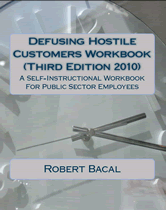
Dealing With Human Speed Bumps!
Mary Duncan, Director of the Income Security branch, left the staff meeting with her stomach churning and her blood pressure high. Sitting down alone in her office she wondered to herself whether John, an office head was going to continue to obstruct implementation of anything new or different. "He must know that the politicians had already decided about the changes, and that it is our job to implement the changes", she thought to herself. She knew that others in the meeting had shown their impatience when John, yet again, cautioned about the need to go very slowly, or face disaster. The rolling of eyes, the heavy sighs when John spoke didn't bode well, she thought. What to do?
Mary is contending with a common situation, one that we have labelled the human speed bump syndrome. Many work groups and teams have at least one of these bumps in the organization, and they attempt to function just like those speed bumps in mall parking lots; encouraging others to slow down. In the worst cases the human speed bump seems to stall the entire organization, and can be relied upon to puncture any enthusiasm others may have about changes in the organization. ?
Speed Bump Behaviour
At one time or other most of us operate as human speed bumps. In fact, as we will see later, speed bump behaviour isn't all bad; organizations can make effective use of speed bumps to avoid reckless or badly though-out decisions. Here are some behaviours commonly used by human speed bumps.
- . pointing out negative or problematic aspects of a plan, process, or change
- . presenting their objections (sometimes with well thought out reasons, sometimes with only vague, ill-defined objections)
- . resists change, often questioning the need to change . often advises a "go slow" approach, even when it is clear that going slow is impossible or will result in severe negative consequences
- . may stall or procrastinate on doing his/her part, thereby slowing down the entire organization.
Speed Bump Fall-Out
Speed bumps can affect an organization in a number of negative ways, particularly if their abilities aren't channelled effectively. For example, human speed bumps:
. are usually perceived as negative and defeatist by other members of the group, and tend to frustrate others. As a result, they may become involved in open arguments as people lose patience with them.
- . can actually slow down changes or actions that an organization MUST take.
- . can negatively affect group morale and enthusiasm
- . may become performance problems if they perceive that their speed bump contributions are ignored or unwanted
Speed Bump Upsides
While it may sound that human speed bumps are a curse on organizations, it isn't necessarily so. Speed bumps can contribute by helping group members reflect on their actions and decisions, and acting as "sober second thought" so that the organization doesn't make decisions in a flurry of excitement, emotion or group-think. Not only can the human speed bump slow down the organization's ride on the highway s/he can also avoid the vehicle hurtling headlong over the cliff. Just like a car needs brakes to function safely, so does each organization need an ability to look at the downside of decisions and actions. This is particularly the case if the organization has a number of "Hot Rodders" on staff (see article next month).
Dealing With The Speed Bump
We are going to assume that the human speed bump is a competent employee; someone with knowledge and skill. Incompetent speed bumps are a different type of problem, often best handled via standard performance management/coaching processes.
If we scratch the surface of a speed bump, what we may find is someone who is particularly adept at finding the flaws in new plans, decisions, and actions. What we need to do is to allow the speed bump to use that capability in an officially sanctioned way. Consider having the speed bump do a critical analysis of a projected course of action. For example, if the organization has three options, ask that the speed bump analyze and identify BOTH the strengths and weaknesses of each option. It may be necessary to help the person by making sure that the problem is properly defined and the goals of the problem-solving are clear.
It is important that we do not encourage, or even permit the speed bump to take pot-shots at others ideas at every turn. For this reason, it is important that the following rule be followed. If you have criticisms of an approach or plan, feel free to express your concerns, but you will be expected to suggest a better idea. If the group follows this rule, you will find that even the most ardent speed bumps will exercise caution, knowing that they will be asked for their recommendation if they are offering criticism.
It is also important that objections be taken seriously (eg. at meetings, etc), rather than being brushed off as "just so much negativity". Clearly there must be limits, though. There is a point where it becomes obvious that the speed bump has no really good reasons for his/her cautions or objections, and it is at this point that further discussion will be wasteful. Try to listen for two forms of objection. The first seems logical and thought out, while the second sounds more emotional and related to personal discomfort. Do not let the person pass off his/her personal vague discomfort with something as logical argument.
There are situations where the speed bump has become a bona fide impediment to the organization, due to consistent and persistent obstruction. When this occurs, direct manager/team leader intervention is indicated. It is legitimate to talk to the individual privately, to discuss how his/her comments are affecting other organization members. Remember that the human speed bump is a style of interaction, and that the person in question may not be aware that the approach is difficult for others. A good way to begin such a discussion is to ask some questions first. For example:
. Have you noticed that
people seem to be getting a little frustrated at our meetings?
. Have you any ideas
why frustration might be increasing?
. Have you considered
that the WAY you are communicating may be
putting you in a
difficult situation?
If possible, get the human speed bump to generate the solutions, rather than supplying them.
Conclusion:
Organizations need people to help them reflect on decisions and actions, and to prevent them from plunging over cliffs because of group-think, over-enthusiasm, or decision-making done under stressful and pressure situations. That said, speed bumps can be disruptive and frustrating. Keep in mind that it will be far easier to channel the abilities of the speed bump into useful action, than to change the style of the speed bump.
Bacal & Associates offers help cards on a number of subjects.To
view samples of the cards click here.





